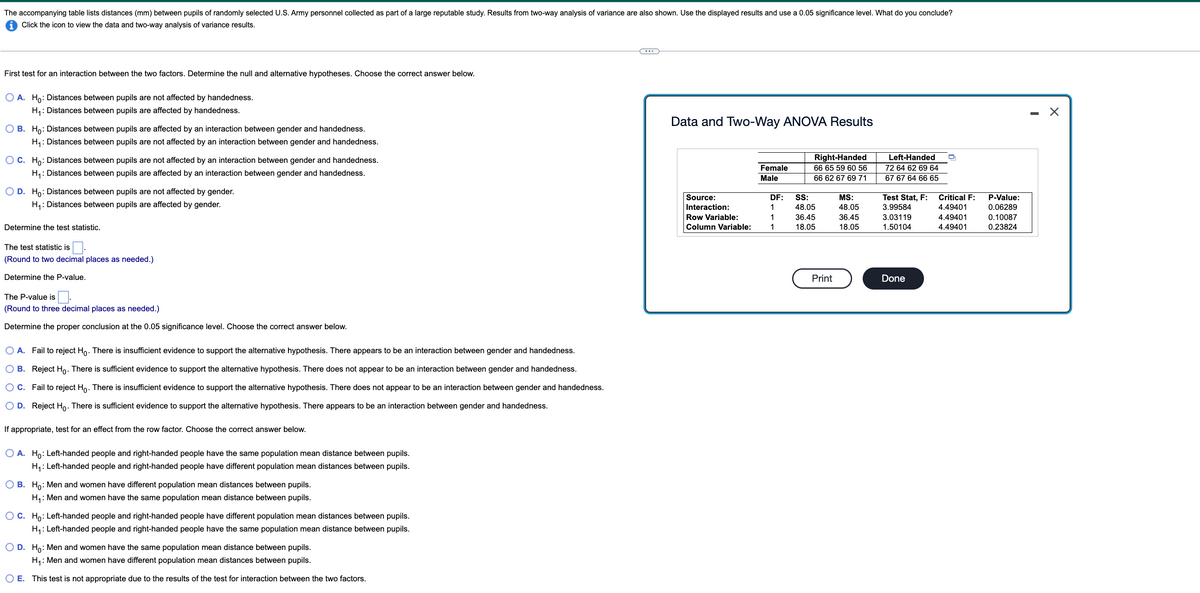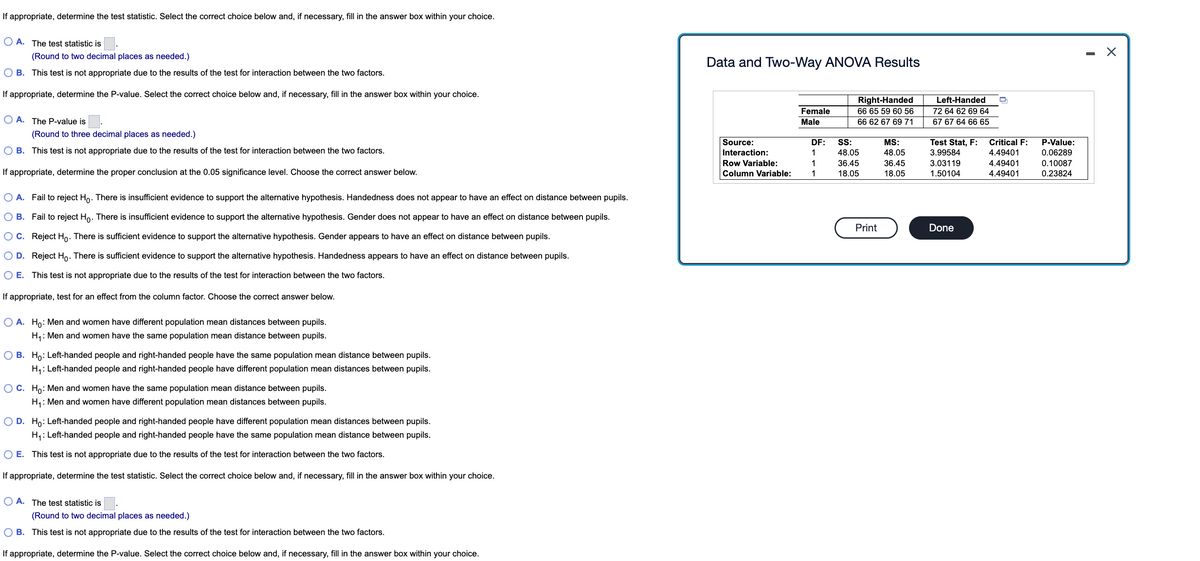The accompanying table lists distances (mm) between pupils of randomly selected U.S. Amy personnel collected as part of a large reputable study. Results from two-way analysis of variance are also shown. Use the displayed results and use a 0.05 significance level. What do you conclude? O Click the icon to view the data and two-way analysis of variance results. First test for an interaction between the two factors. Determine the null and alternative hypotheses. Choose the correct answer below. OA H: Distances between pupils are not affected by handedness. H: Distances between pupils are affected by handedness. Data and Two-Way ANOVA Results OB. Hg: Distances between pupils are affected by an interaction between gender and handedness. H.: Distances between pupils are not affected by an interaction between gender and handedness. Right-Handed 66 65 59 60 56 72 64 62 69 64 66 62 67 69 71 67 67 64 66 65 Left-Handed OC. H: Distances between pupils are not affected by an interaction between gender and handedness. H: Distances between pupils are affected by an interaction between gender and handedness. OD. H: Distances between pupils are not affected by gender. Female Male Source: Interaction: Row Variable: Column Variable: DF: S: 1 1 1 Test Stat, F: Critical F: P-Value: 3.99584 3.03119 MS: H: Distances between pupils are affected by gender. 48.05 48.05 4.49401 0.06289 36.45 36.45 18.05 4.49401 0.10087 Determine the test statistic. 18.05 1.50104 4.49401 0.23824 The test statistic is (Round to two decimal places as needed.) Determine the Pvalue. Print Done The P-value is (Round to three decimal places as needed.)
The accompanying table lists distances (mm) between pupils of randomly selected U.S. Amy personnel collected as part of a large reputable study. Results from two-way analysis of variance are also shown. Use the displayed results and use a 0.05 significance level. What do you conclude? O Click the icon to view the data and two-way analysis of variance results. First test for an interaction between the two factors. Determine the null and alternative hypotheses. Choose the correct answer below. OA H: Distances between pupils are not affected by handedness. H: Distances between pupils are affected by handedness. Data and Two-Way ANOVA Results OB. Hg: Distances between pupils are affected by an interaction between gender and handedness. H.: Distances between pupils are not affected by an interaction between gender and handedness. Right-Handed 66 65 59 60 56 72 64 62 69 64 66 62 67 69 71 67 67 64 66 65 Left-Handed OC. H: Distances between pupils are not affected by an interaction between gender and handedness. H: Distances between pupils are affected by an interaction between gender and handedness. OD. H: Distances between pupils are not affected by gender. Female Male Source: Interaction: Row Variable: Column Variable: DF: S: 1 1 1 Test Stat, F: Critical F: P-Value: 3.99584 3.03119 MS: H: Distances between pupils are affected by gender. 48.05 48.05 4.49401 0.06289 36.45 36.45 18.05 4.49401 0.10087 Determine the test statistic. 18.05 1.50104 4.49401 0.23824 The test statistic is (Round to two decimal places as needed.) Determine the Pvalue. Print Done The P-value is (Round to three decimal places as needed.)
A First Course in Probability (10th Edition)
10th Edition
ISBN:9780134753119
Author:Sheldon Ross
Publisher:Sheldon Ross
Chapter1: Combinatorial Analysis
Section: Chapter Questions
Problem 1.1P: a. How many different 7-place license plates are possible if the first 2 places are for letters and...
Related questions
Question
11.

Transcribed Image Text:The accompanying table lists distances (mm) between pupils of randomly selected U.S. Army personnel collected as part of a large reputable study. Results from two-way analysis of variance are also shown. Use the displayed results and use a 0.05 significance level. What do you conclude?
i Click the icon to view the data and two-way analysis of variance results.
First test for an interaction between the two factors. Determine the null and alternative hypotheses. Choose the correct answer below.
O A. Ho: Distances between pupils are not affected by handedness.
H4: Distances between pupils are affected by handedness.
- X
Data and Two-Way ANOVA Results
O B. Ho: Distances between pupils are affected by an interaction between gender and handedness.
H,: Distances between pupils are not affected by an interaction between gender and handedness.
O C. Ho: Distances between pupils are not affected by an interaction between gender and handedness.
Right-Handed
Left-Handed
Female
66 65 59 60 56
72 64 62 69 64
H,: Distances between pupils are affected by an interaction between gender and handedness.
Male
66 62 67 69 71
67 67 64 66 65
O D. Ho: Distances between pupils are not affected by gender.
H,: Distances between pupils are affected by gender.
Source:
DF:
S:
MS:
Test Stat, F:
Critical F:
P-Value:
Interaction:
1
48.05
48.05
3.99584
4.49401
0.06289
Row Variable:
1
36.45
3.03119
36.45
18.05
4.49401
0.10087
Determine the test statistic.
Column Variable:
1
18.05
1.50104
4.49401
0.23824
The test statistic is
(Round to two decimal places as needed.)
Determine the P-value.
Print
Done
The P-value is.
(Round to three decimal places as needed.)
Determine the proper conclusion at the 0.05 significance level. Choose the correct answer below.
O A. Fail to reject Ho. There is insufficient evidence to support the alternative hypothesis. There appears to be an interaction between gender and handedness.
O B. Reject Ho. There is sufficient evidence to support the alternative hypothesis. There does not appear to be an interaction between gender and handedness.
O C. Fail to reject Ho. There is insufficient evidence to support the alternative hypothesis. There does not appear to be an interaction between gender and handedness.
O D. Reject Ho. There is sufficient evidence to support the alternative hypothesis. There appears to be an interaction between gender and handedness.
If appropriate, test for an effect from the row factor. Choose the correct answer below.
O A. Ho: Left-handed people and right-handed people have the same population mean distance between pupils.
H,: Left-handed people and right-handed people have different population mean distances between pupils.
O B. Ho: Men and women have different population mean distances between pupils.
H,: Men and women have the same population mean distance between pupils.
OC. Ho: Left-handed people and right-handed people have different population mean distances between pupils.
H,: Left-handed people and right-handed people have the same population mean distance between pupils.
O D. Ho: Men and women have the same population mean distance between pupils.
H,: Men and women have different population mean distances between pupils.
O E. This test is not appropriate due to the results of the test for interaction between the two factors.

Transcribed Image Text:If appropriate, determine the test statistic. Select the correct choice below and, if necessary, fill in the answer box within your choice.
O A. The test statistic is
(Round to two decimal places as needed.)
Data and Two-Way ANOVA Results
O B. This test is not appropriate due to the results of the test for interaction between the two factors.
If appropriate, determine the P-value. Select the correct choice below and, if necessary, fill in the answer box within your choice.
Right-Handed
Left-Handed
Female
66 65 59 60 56
72 64 62 69 64
O A. The P-value is
Male
66 62 67 69 71
67 67 64 66 65
(Round to three decimal places as needed.)
Test Stat, F:
3.99584
Source:
DF:
S:
MS:
Critical F:
P-Value:
O B. This test is not appropriate due to the results of the test for interaction between the two factors.
Interaction:
1
48.05
48.05
4.49401
0.06289
Row Variable:
1
4.49401
36.45
18.05
36.45
3.03119
0.10087
If appropriate, determine the proper conclusion at the 0.05 significance level. Choose the correct answer below.
Column Variable:
1
18.05
1.50104
4.49401
0.23824
O A. Fail to reject Ho. There is insufficient evidence to support the alternative hypothesis. Handedness does not appear to have an effect on distance between pupils.
O B. Fail to reject Ho. There is insufficient evidence to support the alternative hypothesis. Gender does not appear to have an effect on distance between pupils.
Print
Done
OC. Reject Ho. There is sufficient evidence to support the alternative hypothesis. Gender appears to have an effect on distance between pupils.
O D. Reject Ho. There is sufficient evidence to support the alternative hypothesis. Handedness appears to have an effect on distance between pupils.
O E. This test is not appropriate due to the results of the test for interaction between the two factors.
If appropriate, test for an effect from the column factor. Choose the correct answer below.
O A. Ho: Men and women have different population mean distances between pupils.
H,: Men and women have the same population mean distance between pupils.
O B. Ho: Left-handed people and right-handed people have the same population mean distance between pupils.
H,: Left-handed people and right-handed people have different population mean distances between pupils.
O C. Ho: Men and women have the same population mean distance between pupils.
H,: Men and women have different population mean distances between pupils.
O D. Ho: Left-handed people and right-handed people have different population mean distances between pupils.
H4: Left-handed people and right-handed people have the same population mean distance between pupils.
O E. This test is not appropriate due to the results of the test for interaction between the two factors.
If appropriate, determine the test statistic. Select the correct choice below and, if necessary, fill in the answer box within your choice.
O A. The test statistic is.
(Round to two decimal places as needed.)
O B. This test is not appropriate due to the results of the test for interaction between the two factors.
If appropriate, determine the P-value. Select the correct choice below and, if necessary, fill in the answer box within your choice.
Expert Solution
This question has been solved!
Explore an expertly crafted, step-by-step solution for a thorough understanding of key concepts.
This is a popular solution!
Trending now
This is a popular solution!
Step by step
Solved in 3 steps

Recommended textbooks for you

A First Course in Probability (10th Edition)
Probability
ISBN:
9780134753119
Author:
Sheldon Ross
Publisher:
PEARSON


A First Course in Probability (10th Edition)
Probability
ISBN:
9780134753119
Author:
Sheldon Ross
Publisher:
PEARSON
